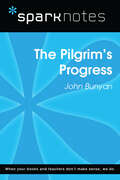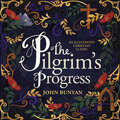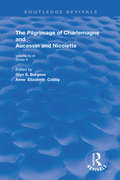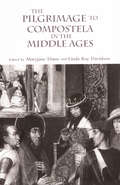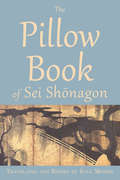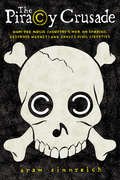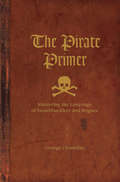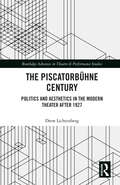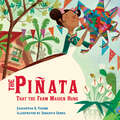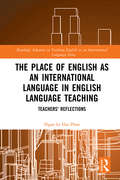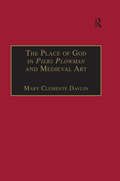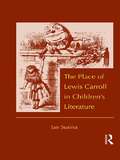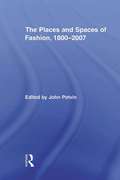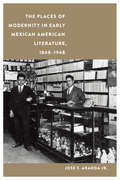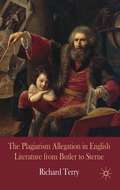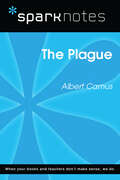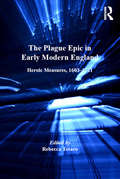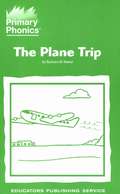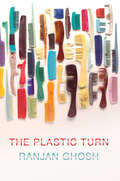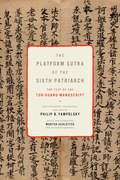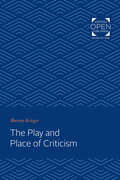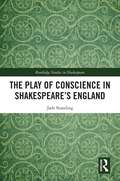- Table View
- List View
The Pilgrim's Progress (SparkNotes Literature Guide Series)
by SparkNotesThe Pilgrim's Progress (SparkNotes Literature Guide) by John Bunyan Making the reading experience fun! Created by Harvard students for students everywhere, SparkNotes is a new breed of study guide: smarter, better, faster. Geared to what today's students need to know, SparkNotes provides: *Chapter-by-chapter analysis *Explanations of key themes, motifs, and symbols *A review quiz and essay topicsLively and accessible, these guides are perfect for late-night studying and writing papers
The Pilgrim's Progress: An Illustrated Christian Classic
by John BunyanThe Pilgrim&’s Progress has inspired readers across the centuries to persevere in their faith. For longstanding fans of Bunyan&’s tale, or for those encountering it for the first time, this illustrated edition offers new beauty and insight with striking hand-painted illustrations and enlightening commentary for all ages. Inside you&’ll find:15 chapters, accompanied by gorgeous hand-painted scenes at the beginning of each chapterannotations embedded across every chapter to help readers gain a deeper understanding of the allegorya presentation page for thoughtful gifting and a notes section to write down your thoughtsa ribbon marker for easy referencingcolorful artwork throughout the entire bookOriginally written for the everyman, John Bunyan's Christian classic has since found its way into the libraries of scholars and universities as well—a true masterpiece for the ages. Its historical richness, eloquent symbolism, and stunning prose have withstood the test of time, and this new edition helps readers appreciate the timeless beauty found in Bunyan&’s words.The Pilgrim&’s Progress is perfect for:homeschooling families or an addition to your family librarymen, women, and children who enjoy learning about historySince its publication in 1678, The Pilgrim&’s Progress has been translated into more than 200 languages. It's a worldwide bestseller, second only to the Bible, and it has become a hallmark among scholars and theologians around the globe.
The Pilgrimage of Charlemagne and Aucassin and Nicolette (Routledge Revivals)
by Glyn S. Burgess Anne Elizabeth CobbyOriginally compiled and published in 1988, this volume contains the text and translation of 'The Pilgrimmage of Charlemagne' and 'Aucassin and Nicolette,' alongisde textual notes and a bibliography for both.
The Pilgrimage to Compostela in the Middle Ages: A Book of Essays (Garland Mediaeval Casebooks Ser. #Vol. 17)
by Maryjane Dunn and Linda Kay DavidsonNine new studies address the phenomenon of the medieval pilgrimage to Santiago de Compostela, the legendary burying place of St. James.
The Pillow Book of Sei Shōnagon (Translations from the Asian Classics)
by Ivan MorrisThe Pillow Book of Sei Shonagon is a fascinating, detailed account of Japanese court life in the eleventh century. Written by a lady of the court at the height of Heian culture, this book enthralls with its lively gossip, witty observations, and subtle impressions. Lady Shonagon was an erstwhile rival of Lady Murasaki, whose novel, The Tale of Genji, fictionalized the elite world Lady Shonagon so eloquently relates. Featuring reflections on royal and religious ceremonies, nature, conversation, poetry, and many other subjects, The Pillow Book is an intimate look at the experiences and outlook of the Heian upper class, further enriched by Ivan Morris's extensive notes and critical contextualization.
The Piracy Crusade: How the Music Industry's War on Sharing Destroys Markets and Erodes Civil Liberties
by Aram SinnreichIn the decade and a half since Napster first emerged, forever changing the face of digital culture, the claim that "internet pirates killed the music industry" has become so ubiquitous that it is treated as common knowledge. Piracy is a scourge on legitimate businesses and hard-working artists, we are told, a "cybercrime" similar to identity fraud or even terrorism. In The Piracy Crusade, Aram Sinnreich critiques the notion of "piracy" as a myth perpetuated by today's cultural cartels--the handful of companies that dominate the film, software, and especially music industries. As digital networks have permeated our social environment, they have offered vast numbers of people the opportunity to experiment with innovative cultural and entrepreneurial ideas predicated on the belief that information should be shared widely. This has left the media cartels, whose power has historically resided in their ability to restrict the flow of cultural information, with difficult choices: adapt to this new environment, fight the changes tooth and nail, or accept obsolescence. Their decision to fight has resulted in ever stronger copyright laws and the aggressive pursuit of accused infringers. Yet the most dangerous legacy of this "piracy crusade" is not the damage inflicted on promising start-ups or on well-intentioned civilians caught in the crosshairs of file-sharing litigation. Far more troubling, Sinnreich argues, are the broader implications of copyright laws and global treaties that sacrifice free speech and privacy in the name of combating the phantom of piracy--policies that threaten to undermine the foundations of democratic society.
The Pirate Primer: Mastering the Language of Swashbucklers and Rogues
by George ChoundasEbbry-blastin'-theng ye needs must know-oo to lay tongue liker aargh-thentic pirate, by the devil's twisted tail.Take a tour through the world of piracy with the only authoritative work on the pirate language. A comprehensive course in pirate vocabulary, pronunciation, grammar, and syntax, The Pirate Primer contains three centuries of distinctive terms and usages uttered by (and attributed to) pirates in film, TV, literature, and history. Discover more than 100 pages of threats, curses, oaths, insults, and epithets; 31 types of pirate drink; 60 different pirate terms for ''woman''; 67 kinds of pirate torture and punishment; 44 distinct definitions of ''aargh''; and more. Each entry in the Primer is accompanied by an excerpt, so you can see the words and phrases used in proper context by actual pirates. And each linguistic concept is introduced by a related anecdote or narrative account, so you can live the language while you learn it. Whether you're simply fascinated by the culture of the Brethren of the Coast or you fancy yourself a modern-day corsair, The Pirate Primer is your guide to authentic pirate speak. Should you ever stare down Davy Jones and he demands proof that you're one who flies no flag, despair not. You'll be able to talk the talk, and no mistake.
The Piscatorbühne Century: Politics and Aesthetics in the Modern Theater After 1927 (Routledge Advances in Theatre & Performance Studies)
by Drew LichtenbergThis study of the Piscatorbühne season of 1927–1928 uncovers a vital, previously neglected current of radical experiment in modern theater, a ghost in the machine of contemporary performance practices. A handful of theater seasons changed the course of 20th- and 21st-century theatre. But only the Piscatorbühne of 1927–1928 went bankrupt in less than a year. This exploration tells the story of that collapse, how it predicted the wider collapse of the late Weimar Republic, and how it relates to our own era of political polarization and economic instability. As a wider examination of Piscator’s contributions to dramaturgical and aesthetic form, The Piscatorbühne Century makes a powerful and timely case for the renewed significance of the broader epic theater tradition. Drawing on a rich archive of interwar materials, Drew Lichtenberg reconstructs this germinal nexus of theory and praxis for the modern theatre. This book will be of great interest to students and scholars in theatre, performance, art, and literature.
The Piñata That the Farm Maiden Hung
by Samantha R. VamosThis is the bilingual story of the farm maiden and her cadre of animals, who crafted a festive piñata for a surprise birthday party. A beautiful and lively companion to the award-winning The Cazuela That the Farm Maiden Stirred.A young girl sets out on errands for the day, and while she's gone, the farm maiden prepares a piñata from scratch with help from a boy, horse, goose, cat, sheep, and farmer. After they all fall asleep in the afternoon sun, they must scramble to finish preparations in time--just as the girl arrives back to her surprise party. Key English words change to Spanish as the cumulative verse builds to the celebratory ending. With the familiarity of "The House That Jack Built," the tale cleverly incorporates Spanish words, adding a new one in place of the English word from the previous page. This book makes learning the language easy and fun. Back matter includes a glossary, definitions, and directions for making a piñata at home."Delightful and engaging"--Foreword Reviews, STARRED review
The Place of English as an International Language in English Language Teaching: Teachers' Reflections (Routledge Advances in Teaching English as an International Language Series #3)
by Ngan Le PhanThis book aims to contribute to the discipline of teaching English as an international language by exploring teachers’ reflections on the recent changes within the English language for their teaching profession. It presents a comprehensive and thorough examination of the place of English as an international language in English language teaching, especially in an Asia-Pacific context, looking at Vietnam and countries in which the context of ELT is similar. It examines and revisits the relevance of teaching implications, teaching of cultures and teaching materials currently employed in an EFL context. The author investigates a range of critical issues in teaching English in today’s EFL context as well as challenges in implementing new teaching ideas to meet learners’ demands to communicate with speakers from various backgrounds. Finally, the book presents a number of research-informed implications for pedagogy, theory and research in teaching EIL in ELT.
The Place of God in Piers Plowman and Medieval Art
by Mary Clemente DavlinProbing spatial questions about God posed by Piers Plowman, the author of this interdisciplinary study turns to pictorial evidence-the use of religious space and relationships within such space in English art of the same period. The Place of God in Piers Plowman and Medieval Art is not only a study of the sense of God and of the relationship between God and creatures in the great religious poem, but also an analysis of art works of the high Middle Ages, especially English manuscript illuminations, in their placement of God. Such interdisciplinary analysis historicizes both literature and art, uncovering ways that medieval people imagined God and the understandings that they would have been able to bring to reading and viewing religious art.
The Place of Lewis Carroll in Children's Literature (Children's Literature and Culture)
by Jan SusinaIn this volume, Jan Susina examines the importance of Lewis Carroll and his popular Alice books to the field of children’s literature. From a study of Carroll’s juvenilia to contemporary multimedia adaptations of Wonderland, Susina shows how the Alice books fit into the tradition of literary fairy tales and continue to influence children’s writers. In addition to examining Carroll’s books for children, these essays also explore his photographs of children, his letters to children, his ill-fated attempt to write for a dual audience of children and adults, and his lasting contributions to publishing. The book addresses the important, but overlooked facet of Carroll’s career as an astute entrepreneur who carefully developed an extensive Alice industry of books and non-book items based on the success of Wonderland, while rigorously defending his reputation as the originator of his distinctive style of children’s stories.
The Places and Spaces of Fashion, 1800-2007 (Routledge Research in Cultural and Media Studies #16)
by John PotvinThe Places and Spaces of Fashion, 1800-2007 brings together art, design, fashion, and a much neglected concern for its spatial realities. The spaces and places of fashion have often been overlooked in the writing of fashion history and visual culture. More often than not, however, these environments mitigate, control, inform, and enhance how fashion is experienced, performed, consumed, seen, exhibited, purchased, appreciated and of course displayed. Space, as this volume attempts to illustrate, is itself a representational strategy on par with and influencing the visibility and visuality of fashion. Innovative and challenging, the essays in this volume explore various physical and conceptual spaces, moving from physical environments to the two-dimensional with paintings, illustrations, and photographs to chart similarities, differences, and complex nuanced relationships between environments, fashion, identities, and visuality. The volume also navigates various sites (both permanent and temporary) of production, circulation, exhibition, consumption, and promotion of fashion that define meaning and knowledge about a culture or individual by providing for a bond between embodied consumers/spectators and fashion objects. The Places and Spaces of Fashion, 1800-2007 is a compelling project with a thematic, theoretical, and historiographic approach that is at once both focused yet far-reaching and original in its implications. The volume engages with questions attending to the ‘modern condition’ by seamlessly weaving interdisciplinary discussions of the visual with material culture to explore the spatial dimension(s) of fashion. Some of the essays explore new and exciting spaces while others offer compelling revisionary analyses of relatively known sources
The Places of History: Regionalism Revisited in Latin America
by Doris SommerResponding to the pressures of current theoretical trends toward models of cultural globalization, the essays collected here bring a historical focus to literary studies. They suggest that only by exploring the particularities of regional historical cultures can the multiple meanings of American identities be understood. Representing a broad range of contemporary criticism, this volume features many short essays by the most well-known and respected Latin Americanists, each devoting attention to specific matters of history. The topics range from Incan architecture to Chicano and Nuyorican habitats; from turn of the century Argentine criminology to Caribbean homophobia; from the rhetorics of independence and dictatorship to Mexican ambivalence about opera and Brazil's move beyond monarchy; and from the precarious survival of Spanish language in Latin America to its paradoxical legacy of enlightenment in the Philippines. Originally published as a special issue of Modern Language Quarterly (June 1996), this expanded edition includes a new introduction by Doris Sommer and a new essay by Vincente Rafael. Viewed together, these essays reveal a cultural richness that is sure to interest literary scholars and Latin Americanists alike.Contributors. Carlos J. Alonso, Antonio Benítez-Rojo, John Beverley, Debra A. Castillo, Arcadio Diaz-Quiñones, Juan Flores, Mary M. Gaylord, José Limón, Josefina Ludmer, Francine Masiello, Antonio Mazzotti, Walter D. Mignolo, Sylvia Molloy, Mary Louise Pratt, Vincente Rafael, Julio Ramos, Susana Rotker, Roberto Schwarz, Diana Taylor, Nancy Vogeley
The Places of Modernity in Early Mexican American Literature, 1848–1948 (Postwestern Horizons)
by José F. Aranda Jr.In The Places of Modernity in Early Mexican American Literature, 1848–1948, José F. Aranda Jr. describes the first one hundred years of Mexican American literature. He argues for the importance of interrogating the concept of modernity in light of what has emerged as a canon of earlier pre-1968 Mexican American literature. In order to understand modernity for diverse communities of Mexican Americans, he contends, one must see it as an apprehension, both symbolic and material, of one settler colonial world order giving way to another more powerful colonialist but imperial vision of North America. Letters, folklore, print culture, and literary production demonstrate how a new Anglo-American political imaginary revised and realigned centuries-old discourses on race, gender, class, religion, citizenship, power, and sovereignty. The &“modern,&” Aranda argues, makes itself visible in cultural productions being foisted on a &“conquered people,&” who were themselves beneficiaries of a notion of the modern that began in 1492. For Mexican Americans, modernity is less about any particular angst over global imperial designs or cultures of capitalism and more about becoming the subordinates of a nation-building project that ushers the United States into the twentieth century.
The Plagiarism Allegation in English Literature from Butler to Sterne
by Richard TeryContributing to the growth in plagiarism studies, this timely new book highlights the impact of the allegation of plagiarism on the working lives of some of the major writers of the period, and considers plagiarism in relation to the emergence of literary copyright and the aesthetic of originality.
The Plague (SparkNotes Literature Guide Series)
by SparkNotesThe Plague (SparkNotes Literature Guide) by Albert Camus Making the reading experience fun! Created by Harvard students for students everywhere, SparkNotes is a new breed of study guide: smarter, better, faster. Geared to what today's students need to know, SparkNotes provides: *Chapter-by-chapter analysis *Explanations of key themes, motifs, and symbols *A review quiz and essay topicsLively and accessible, these guides are perfect for late-night studying and writing papers
The Plague Epic in Early Modern England: Heroic Measures, 1603–1721
by Rebecca TotaroThe Plague Epic in Early Modern England: Heroic Measures, 1603-1721 presents together, for the first time, modernized versions of ten of the most poignant of plague poems in the English language - each composed in heroic verse and responding to the urgent need to justify the ways of God in times of social, religious, and political upheaval. Showcasing unusual combinations of passion and restraint, heart-rending lamentation and nation-building fervor, these poems function as literary memorials to the plague-time fallen. In an extended introduction, Rebecca Totaro makes the case that these poems belong to a distinct literary genre that she calls the 'plague epic.' Because the poems are formally and thematically related to Milton's great epics Paradise Lost and Paradise Regained, this volume represents a rare discovery of previously unidentified sources of great value for Milton studies and scholarly research into the epic, didactic verse, cultural studies of the seventeenth century, illness as metaphor, and interdisciplinary approaches to illness, natural disaster, trauma, and memory.
The Plague and I
by Betty MacdonaldBetty MacDonald had divorced her first husband, (meet him in "The Egg and I," which is available from Bookshare) and had moved back home with her two girls. She was working in an office when the overwhelming fatigue and exhausting cough began. Without much money, she had few choices, which is why she went to The Pines. This biographical book provides us with detailed looks at how tuberculosis was treated during the 1940s and what sanatoriums were like. Other books for adults and children by Betty MacDonald are available from Bookshare.
The Plastic Turn
by Ranjan GhoshThe Plastic Turn offers a novel way of looking at plastic as the defining material of our age and at the plasticity of plastic as an innovative means of understanding the arts and literature. Ranjan Ghosh terms this approach the material-aesthetic and, through this concept, traces the emergence and development of plastic polymers along the same historical trajectory as literary modernism. Plastic's growth as a product in the culture industry, its formation through multiple application and chemical syntheses, and its circulation via oceanic movements, Ghosh argues, correspond with, and offers novel insights into, developments in modernist literature and critical theory.Through innovative readings of canonical modernist texts, analyses of art works, and accounts of plastic's devastating environmental impact, The Plastic Turn proposes plastic's unique properties and destructive ubiquity as a "theory machine" to explain literature and life in the Anthropocene. Introducing several new concepts (like plastic literature, plastic literary, etc.) into critical-humanist discourse, Ghosh enmeshes literature and theory, materiality and philosophy, history and ecology, to explore why plastic as a substance and as an idea intrigues, disturbs, and haunts us.
The Platform Sutra of the Sixth Patriarch: The Text of the Tun-Huang Manuscript (Translations from the Asian Classics #No. 76)
by Philip B. YampolskyDating back to the eighth century C.E., the Platform Sutra of the Sixth Patriarch is a foundational text of Chan/Zen Buddhism that reveals much about the early evolution of Chinese Chan and the ideological origins of Japanese Zen and Korean Son. Purported to be the recorded words of the famed Huineng, who was understood to be the Sixth Patriarch of Chan and the father of all later Chan/Zen Buddhism, the Platform Sutra illuminates fundamental Chan Buddhist principles in an expressive sermon that describes how Huineng overcame great personal and ideological challenges to uphold the exalted lineage of the enlightened Chan patriarchs while realizing the ultimate Buddhist truth of the original, pure nature of all sentient beings.Huineng seems to reject meditation, the value of good karma, and the worship of the buddhas, conferring instead a set of "formless precepts" on his audience, marked by embedded notes in the text. In his central message, an inherent, perfect buddha nature stands as the original true condition of all sentient beings, which people of all backgrounds can experience for themselves. Philip Yampolsky's masterful translation contains extensive explanatory notes and an edited, amended version of the Chinese text. His introduction critically considers the background and historical setting of the work and locates Huineng's place within the history and legends of Chan Buddhism. This new edition features a foreword by Morten Schlütter further situating the Platform Sutra within recent historical research and textual evidence, and an updated glossary that includes the modern pinyin system of transcription.
The Platonian Leviathan
by Leon Harold CraigThomas Hobbes's influential political treatise, Leviathan, was first published in 1651. Many scholars have since credited him with a mechanistic outlook towards human nature that established the basis of modern Western political philosophy from the perspective of social contract theory. In The Platonian Leviathan, Leon Harold Craig weaves together philosophy, political science, and literature to offer a radical re-interpretation of Hobbes's most famous work.Though Craig begins and concludes his analysis with discussions of Herman Melville's Moby-Dick and includes an essay on Joseph Conrad's Heart of Darkness, the bulk of his two-part commentary centres on Leviathan. Part One shows the overt principles of Hobbes's political prescription to be untenable, and strongly suggests that Hobbes himself did not subscribe to these rules, using them only as tools to further his philosophical goals. In Part Two, Craig displays the underlying Platonism of Hobbes's thinking. Sure to be controversial, The Platonian Leviathan may nonetheless re-orient the future direction of Hobbes scholarship.
The Play and Place of Criticism
by Murray KriegerOriginally published in 1967. In The Play and Place of Criticism, Professor Krieger addresses basic questions related to criticism in the title essay that forms the introduction to this collection and that constitutes a considered statement of his "contextualist" position. In agreement with Spitzer, Krieger believes that the critic has a valuable part to play in relating the "new words" of the individual poem to the "old words" of the language. He goes further in identifying the role of the critic as essentially rhapsodic, a sharing-in and an expression of the poet's "fine frenzy," which, when it succeeds, transports the critic beyond words and dooms his analytical efforts to failure. Thus, while defending the critic's right to exercise "the free play of the mind" in approaching his subject, the author insists that the critic recognize his subordinate "place" in performing his act of mediation. Elsewhere in the volume Krieger uses other terms and metaphors to explore similar problems revolving around the mediate and the immediate in poetry and criticism. In calling for a poetry of "still movement," for example, he examines both the opposition and the union of temporal with spatial or plastically formal elements, of the dynamically empirical with the statically archetypal. Having defined his critical position in these ways, Krieger relates it to other schools of criticism and applies its methods to the analysis of works by Shakespeare, Pope, Arnold, Hawthorne, and others.
The Play of Conscience in Shakespeare’s England (Routledge Studies in Shakespeare)
by Jade StandingHaving a conscience distinguishes humans from the most advanced AI systems. Acting in good conscience, consulting one’s conscience, and being conscience-wracked are all aspects of human intelligence that involve reckoning (deriving general laws from particular inputs and vice versa), and judgement (contemplating the relationship of the reckoning system to the world). While AI developers have mastered reckoning, they are still working towards the creation of judgement. This book sheds light on the reckoning and judgement of conscience by demonstrating how these concepts are explored in Everyman, Doctor Faustus, The Merchant of Venice, and Hamlet. Academic, student, or general-interest readers discover the complexity and multiplicity of the early modern concept of conscience, which is informed by the scholastic intellectual tradition, juridical procedures of the court of Chancery, the practical advice of Protestant casuistry, and Reformation theology. The aims are to examine the rubrics for thinking through, regulating, and judging actions that define the various consciences of Shakespeare’s day, to use these rubrics to interpret questions of truth and action in early modern plays, and to offer insights into what it is about conscience that developers want to grasp to eliminate the difference between human and non-human intelligences, and achieve true AI.
